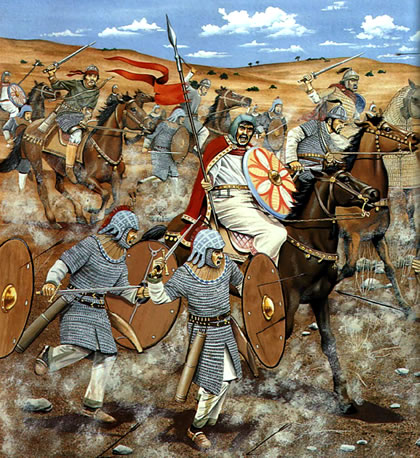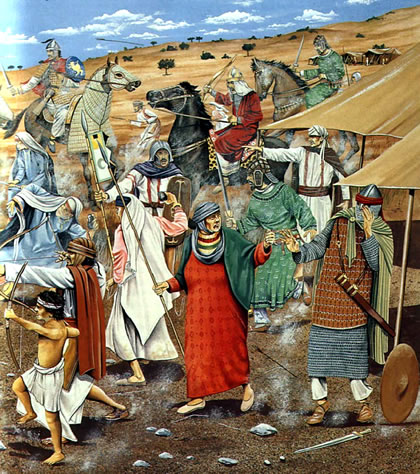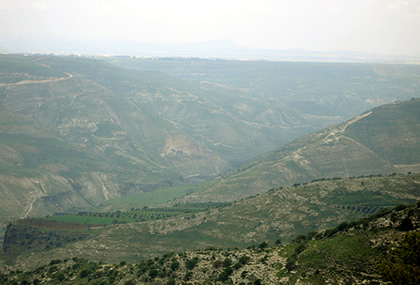World History
The Battle of Yarmuk (a tributary of the Jordan River), close to the present-day border of Syria and Jordan, was a decisive battle between the Byzantine Empire and the rapidly expanding Arab Islamic empire. In the 630s as Arab forces advanced out of the Arabian Peninsula into Iraq in the east and greater Syria in the northeast they encroached deep inside Byzantine territory.
When they lay siege to Damascus and other major cities, the Byzantine emperor Heraclius (r. 610–641) grew alarmed and raised a large army of Greek and native Arabs in the eastern Mediterranean to defeat the Muslim army. However the Arab Islamic forces of Bedu tribespeople were often joined by Arab volunteers, many of them Christians, who had become disaffected by Byzantine policies and high taxation.
The able Arab commander Khalid ibn al-Walid had already achieved major military victories in the Arabian Peninsula and was a keen strategist. The Arabs also enjoyed the advantages of a new dynamic religious faith, mobility, and a willingness to fight in the heat of the midday with scant water supplies.
The Arab forces only numbered about 25,000; although the commonly given number of 90,000 Byzantine troops is an exaggeration, the Byzantines clearly outnumbered the Arabs. In August 636, when the Arab and Byzantine forces met along the Yarmuk River, which is traversed by deep ravines, the forces were spread out over several kilometers. The fighting lasted for six days and several times seemed to shift in favor of the Byzantines.
In keeping with Arab tradition, women and children accompanied the forces in wartime and on several well-documented occasions the women urged the men forward and even marched toward the Greeks armed with swords and tent posts. Fifty-year-old Hind Bint Utba, who had already earned a reputation as a formidable force in the Islamic community, marshaled troops in defense of their positions.
Allegedly, the Greeks were so startled by the sight of armed women that some jumped over a cliff at the edge of the battlefield. By the end of the sixth day of fighting the Arabs were clearly victorious and, with no backup plans, the Byzantine forces retreated into the Anatolian Peninsula.
The victory at Yarmuk paved the way for the conquest of Damascus and then Jerusalem in 638. The inhabitants of Jerusalem handed the city, considered sacred to Jews, Christians, and Muslims, directly to Caliph Omar. The newly gained territories of the eastern Mediterranean were consolidated under the Umayyad Caliphate led by Caliph Muaw’iya, Hind’s son, and Damascus was made the new capital.
Arab forces also went on to conquer Egypt and North Africa. The new Arab Islamic empire assimilated many Byzantine cultural and architectural styles and many of the Arab Christians, who were not forced to convert, gradually adopted Arabic as the primary language.
- Berbers
Tariq ibn al-Ziyad, a berber commander The Berbers are the earliest known inhabitants of northwestern Africa’s Mediterranean coast, plains, and mountain ranges. Living as nomadic herders or farmers in Morocco’s Atlas and Rif mountain ranges,...
- Arab Conquest Of Sind
Arab conquest of Sind Sind (or Sindh) is a province of modern-day Pakistan. It is bounded by the Thar Desert to the east, the Kirthar Mountains to the west, and the Arabian Sea to the south. The Indus River passes through Sind and its irrigation was...
- Umayyad Dynasty
Umayyad Dynasty at its greatest extent After Ali’s death and his son Hasan’s renunciation of the caliphate, Muaw’iya became the undisputed caliph of the Muslim world in 661. He established a hereditary dynasty with Damascus as its...
- History Of Israel
History of Israel. This site has an essay on the modern history of Israel. No ancient history here as the essay starts with 1948. The Encyclopedia Britannica notes that Israel is a, "country in the Middle East, located at the eastern end of the Mediterranean...
- The Glory Of Byzantium
The Glory of Byzantium - An exhibition at the Metropolitan Museum of Art celebrating the second golden age of Byzantine art. Includes Byzantine art themes, the history of Byzantium, and a visual timeline. The exhibit is long gone (it ended in 1997) but...
World History
Battle of Yarmuk
 |
| Byzantine troops in Battle of Yarmuk |
The Battle of Yarmuk (a tributary of the Jordan River), close to the present-day border of Syria and Jordan, was a decisive battle between the Byzantine Empire and the rapidly expanding Arab Islamic empire. In the 630s as Arab forces advanced out of the Arabian Peninsula into Iraq in the east and greater Syria in the northeast they encroached deep inside Byzantine territory.
When they lay siege to Damascus and other major cities, the Byzantine emperor Heraclius (r. 610–641) grew alarmed and raised a large army of Greek and native Arabs in the eastern Mediterranean to defeat the Muslim army. However the Arab Islamic forces of Bedu tribespeople were often joined by Arab volunteers, many of them Christians, who had become disaffected by Byzantine policies and high taxation.
The able Arab commander Khalid ibn al-Walid had already achieved major military victories in the Arabian Peninsula and was a keen strategist. The Arabs also enjoyed the advantages of a new dynamic religious faith, mobility, and a willingness to fight in the heat of the midday with scant water supplies.
  |   |
The Arab forces only numbered about 25,000; although the commonly given number of 90,000 Byzantine troops is an exaggeration, the Byzantines clearly outnumbered the Arabs. In August 636, when the Arab and Byzantine forces met along the Yarmuk River, which is traversed by deep ravines, the forces were spread out over several kilometers. The fighting lasted for six days and several times seemed to shift in favor of the Byzantines.
In keeping with Arab tradition, women and children accompanied the forces in wartime and on several well-documented occasions the women urged the men forward and even marched toward the Greeks armed with swords and tent posts. Fifty-year-old Hind Bint Utba, who had already earned a reputation as a formidable force in the Islamic community, marshaled troops in defense of their positions.
 |
| Muslim troops defending their position |
Allegedly, the Greeks were so startled by the sight of armed women that some jumped over a cliff at the edge of the battlefield. By the end of the sixth day of fighting the Arabs were clearly victorious and, with no backup plans, the Byzantine forces retreated into the Anatolian Peninsula.
The victory at Yarmuk paved the way for the conquest of Damascus and then Jerusalem in 638. The inhabitants of Jerusalem handed the city, considered sacred to Jews, Christians, and Muslims, directly to Caliph Omar. The newly gained territories of the eastern Mediterranean were consolidated under the Umayyad Caliphate led by Caliph Muaw’iya, Hind’s son, and Damascus was made the new capital.
Arab forces also went on to conquer Egypt and North Africa. The new Arab Islamic empire assimilated many Byzantine cultural and architectural styles and many of the Arab Christians, who were not forced to convert, gradually adopted Arabic as the primary language.
 |
| Battlefield of Yarmuk nowdays |
- Berbers
Tariq ibn al-Ziyad, a berber commander The Berbers are the earliest known inhabitants of northwestern Africa’s Mediterranean coast, plains, and mountain ranges. Living as nomadic herders or farmers in Morocco’s Atlas and Rif mountain ranges,...
- Arab Conquest Of Sind
Arab conquest of Sind Sind (or Sindh) is a province of modern-day Pakistan. It is bounded by the Thar Desert to the east, the Kirthar Mountains to the west, and the Arabian Sea to the south. The Indus River passes through Sind and its irrigation was...
- Umayyad Dynasty
Umayyad Dynasty at its greatest extent After Ali’s death and his son Hasan’s renunciation of the caliphate, Muaw’iya became the undisputed caliph of the Muslim world in 661. He established a hereditary dynasty with Damascus as its...
- History Of Israel
History of Israel. This site has an essay on the modern history of Israel. No ancient history here as the essay starts with 1948. The Encyclopedia Britannica notes that Israel is a, "country in the Middle East, located at the eastern end of the Mediterranean...
- The Glory Of Byzantium
The Glory of Byzantium - An exhibition at the Metropolitan Museum of Art celebrating the second golden age of Byzantine art. Includes Byzantine art themes, the history of Byzantium, and a visual timeline. The exhibit is long gone (it ended in 1997) but...
